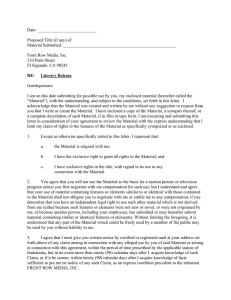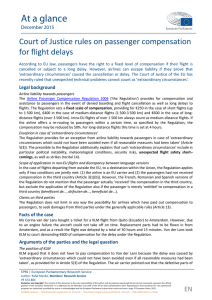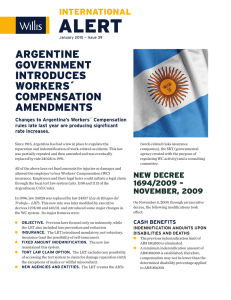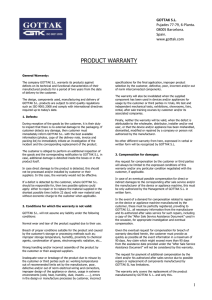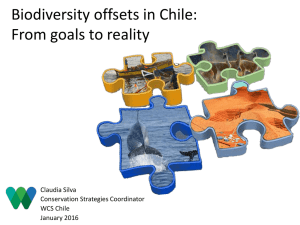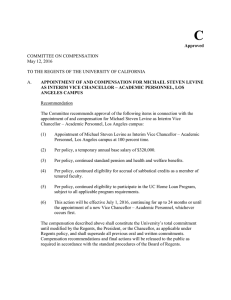Barbot-Dodier2015 Article VictimsNormativeRepertoireOfFi
Anuncio
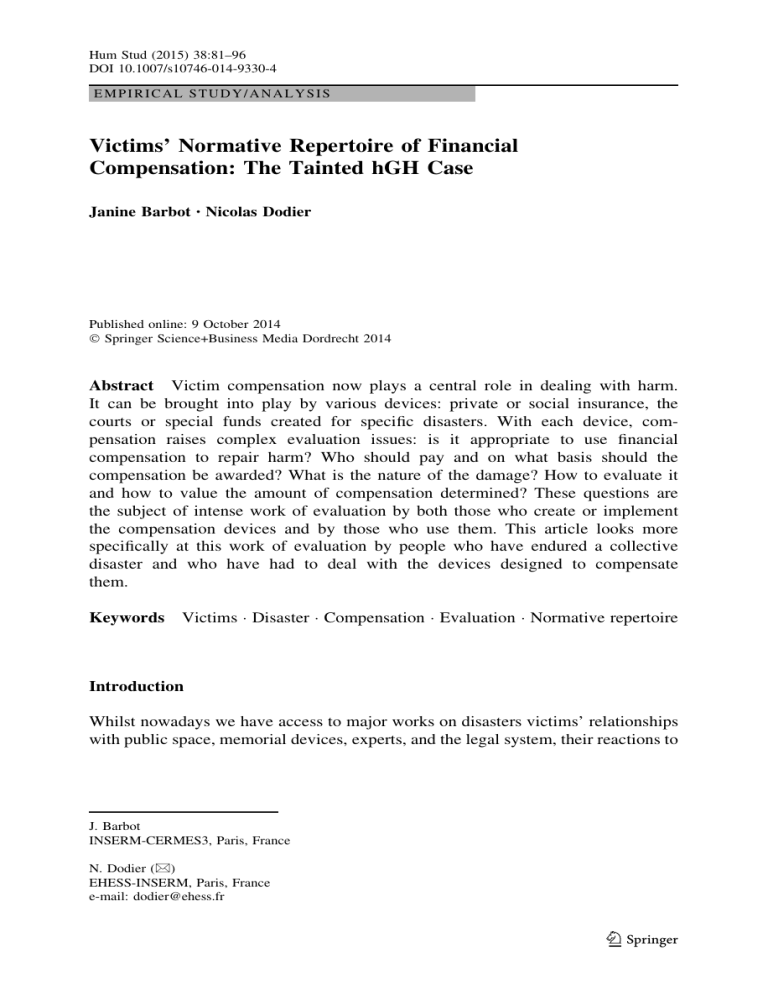
Hum Stud (2015) 38:81–96 DOI 10.1007/s10746-014-9330-4 EMPIRICAL STUDY/ANALYSIS Victims’ Normative Repertoire of Financial Compensation: The Tainted hGH Case Janine Barbot • Nicolas Dodier Published online: 9 October 2014 ! Springer Science+Business Media Dordrecht 2014 Abstract Victim compensation now plays a central role in dealing with harm. It can be brought into play by various devices: private or social insurance, the courts or special funds created for specific disasters. With each device, compensation raises complex evaluation issues: is it appropriate to use financial compensation to repair harm? Who should pay and on what basis should the compensation be awarded? What is the nature of the damage? How to evaluate it and how to value the amount of compensation determined? These questions are the subject of intense work of evaluation by both those who create or implement the compensation devices and by those who use them. This article looks more specifically at this work of evaluation by people who have endured a collective disaster and who have had to deal with the devices designed to compensate them. Keywords Victims ! Disaster ! Compensation ! Evaluation ! Normative repertoire Introduction Whilst nowadays we have access to major works on disasters victims’ relationships with public space, memorial devices, experts, and the legal system, their reactions to J. Barbot INSERM-CERMES3, Paris, France N. Dodier (&) EHESS-INSERM, Paris, France e-mail: dodier@ehess.fr 123 82 J. Barbot, N. Dodier compensation devices remain largely unexplored.1 Two sets of works nevertheless throw some light on this issue and provide us with a general overview of the attitudes towards compensation devices. Following Zelizer (2000), we can group the first set of works together under the heading of ‘‘hostile worlds’’. These works focus on the phenomenon of resistance to monetization regarding entities considered to be incommensurable.2 This resistance might relate to classic pairs of opposition: between exchange-value and use-value (Marx); between sacred and profane (Durkheim); between sacralisation and monetization (Simmel). It might also relate to incompatibilities between the different normative orders which govern our societies: ‘‘spheres of justice’’ (Walzer 1983), or ‘‘polities’’ (Boltanski and Thévenot 1991). So, for example, whilst the construction of value through recourse to monetary equivalences is in line with the principle of the ‘‘market polity,’’ it may be inadmissible in other polities (such as the ‘‘civic polity’’ or the ‘‘domestic polity’’). This first set of works highlights an important aspect of the difficulties that people might encounter when trying to start the compensation process for certain types of harm. It takes account of the ways in which different actors might, for example, try to work around these constraints, by marking the incommensurable nature of what has been lost through the establishment of derisory amounts (the ‘‘symbolic sum of one euro’’) or, on the contrary, of astronomical amounts (Zelizer 1985). The second set of works is embedded within the issue of ‘‘economic valuation technologies’’ (Fourcade 2011a). The general purpose of these works is to describe and compare the processes which construct the ‘‘economic value’’ of entities, be it within or outside markets. More particularly, these works are an extension of the research carried out by Karl Polanyi or Michel Callon on the embeddedness of economic markets, by examining the techniques which allow administrations or the courts (outside the market sphere) to lay the foundations for compensation.3 In particular, they look at the wide range of compensation-building modes and at how these techniques employ appropriate methods for integrating issues of incommensurability. In this way they have highlighted the different methods of calculation (and their inventiveness) employed by compensation devices, but have for the most part done little to clarify how the victims react to these new techniques. 1 There are many works providing detailed descriptions of compensation devices which have been put in place to deal with different types of collective disaster, without necessarily attempting to produce a transversal framework of analysis of victims reactions to these devices (Dodier 2013). See in particular: Schuck (1986) on the damaging effects of agent orange during the Vietnam War, Todeschini (1999) on the Hiroshima bomb, Feldman (2000) on the contaminated blood affair in three countries, Petryna (2002) on the Chernobyl disaster, Jobin (2006) on the industrial pollution affairs in Japan, Fassin and Rechtman (2007) and Latté (2008) on the explosion at the AZF factory in France, Henry (2007) on the asbestos affair in France, Langumier (2008) on the floods in the south of France, Barthe (2010) on the nuclear tests carried out by the French army. 2 According to Zelizer (1979), this resistance explains, for example, the very slow beginnings of the lifeinsurance market in the United States during the first half of the 19th century. Potential life-insurance customers were repelled by the idea of receiving money as a result of a relative’s death. 3 Fourcade (2011a, b) looks at how compensation was calculated for the pollution caused by the wreck of the Amoco Cadiz off the coast of Brittany in 1978 and of the Exxon Valdez in Prince William Sound in Alaska in 1989. 123 Tainted hGH Case 83 This article is located at the intersection of these two sets of works. Its objective is to use the study of a collective disaster to examine how victims deal with compensation mechanisms, through systematic analysis of the expectations and tensions that this confrontation creates. Following the works on ‘‘hostile worlds,’’ it aims to grasp that which, from the victims’ point of view, has proven to be incommensurable. We will however make sure to analyse the different ways in which victims, facing the same collective disaster, attempt to cope with the distress caused by the incommensurability of the harm. We will also see that victims’ experience cannot be reduced to the question of incommensurability and that the moral tension caused by the compensation devices is embedded in the broader set of expectations that they form regarding compensation. It is through these expectations that victims perceive, accept, or refuse the conventions relating to any given compensation device, just as the implementation of a given device helps to transform said expectations and even causes others to emerge. We will use the notion of normative repertoire to analyse how victims evaluate compensation devices and the behaviour relating to them. Anthropologists Comaroff and Roberts (1981) use this notion in their study of Tswana society. Paying careful attention to the way in which, within a given society, individuals evaluate their own behaviour and that of others, the authors reveal the heterogeneous and sometimes contradictory nature of the norms to which these individuals refer. At the same time, Comaroff and Roberts make the hypothesis that above and beyond this observed heterogeneity, one can uncover the general structure which is at the root of all of such evaluations. It is in this sense that they speak of a normative repertoire, in the singular, proper to this society. Even if these norms do not constitute a system, the authors consider that they can be used to extract its ‘‘semantic structure’’ (1981: 261). In using this notion of normative repertoire, we perform two shifts. First of all, we substitute the notion of expectation for that of norm. Comaroff and Roberts use the notion of norm to describe that upon which a normative repertoire is built. They define it as ‘‘a statement of rule that is indigenously regarded as relevant to the regulation of social conduct’’ (1981: 28). We prefere the notion of expectation because it is broader. To a greater extent than the notion of norm, it integrates the fact that evaluations of behaviour often refer to the purpose of the action, which is of the order of what one is trying to achieve. Furthermore, it remains more open than the notion of norm to the way in which the idea of obligation might be expressed. Depending on the case, expectations might be expressed by standards, by explicit rules, categories, evocative words, metaphors, etc. Identifying a normative repertoire thus involves reconstructing the network of expectations to which the actors refer in their evaluations, and the patterns that they mobilise to this effect. Secondly, unlike Comaroff and Roberts, we do not position ourselves at the level of society as a whole, and of the sum of the spheres of social life on which individuals make their evaluations, but at the level of the evaluations that the actors make with regard to a specific device. And it is at this level that we attempt to identify the overall structure upon which the evaluations are based. From this point of view, in this article we examine the normative repertoire of victims of a collective disaster in relation to compensation devices. 123 84 J. Barbot, N. Dodier In terms of a normative repertoire, and as is generally the case when social sciences refer to the notion of ‘‘repertoire,’’ we thus attempt to take account of the heterogeneity of the bases of evaluation. Our approach nevertheless presents specific characteristics. First of all, in this case the normative repertoire refers to the normative basis of the evaluations found at the intersection of different expectations. This is an important difference with research which make every repertoire derive from a central expectation, or from a principle, from which the repertoire draws its consistency.4 These works thus place the emphasis on the plurality of the repertoires and strive to show how they work in combination. Our aim is to identify the single repertoire with which actors evaluate a device and the behaviour relating to it. Where possible, we try to take account of the tensions within this repertoire, and of how the actors attempt to cope with them. In this way we place the actors’ work of evaluation within a temporal dynamic. Finally, we step away from the too narrowly ‘‘strategic’’ stances of the notion of repertoire. For some authors, a ‘‘repertoire’’ is a palette of resources available to actors at a given point in time to support a strategy.5 The notion of normative repertoire which we are putting forward, demonstrates the actors reflexivity in relation to the nature of their expectations regarding a given device. The actors are not immediately within a strategy; they can hesitate as to the specific purpose of the action they intend to take regarding the device. Case and Method We examine the reactions to proposed financial compensation of people in France who were victims of the iatrogenic human growth hormone (hGH). At the beginning of the 1970s, a national hGH production programme was introduced to fight against serious child growth disorders. Up until 1988, the growth hormone was produced using pituitary glands extracted from human cadavers in hospital morgues. This led to patients being contaminated by an infectious agent, the prion, which is responsible for Creutzfeldt–Jakob Disease (CJD). This neurodegenerative disease generally affects older subjects. It causes rapid and irreversible deterioration in the patient’s motor and mental capacities and requires particularly demanding care. CJD causes very significant suffering both to patients and to their friends and relatives. To date in France there have been 120 deaths due to CJD in children treated with hGH.6 4 See for example the notion of ‘‘cultural repertoire’’ (Lamont 1992), or ‘‘repertoire of evaluation’’ (Dupret 2000; Lamont and Thévenot 2000; Lascoumes and Bezes 2009). 5 See for example Swidler (1986) on the cultural repertoire as a ‘‘toolkit’’ with which to build ‘‘strategies of action,’’ or Tilly (1984) on the ‘‘repertoire of collective action’’ as the set of resources available to groups at a given moment in time to defend their interests. 6 In 2012, there were 226 cases of hHG-related iatrogenic CJD in the world: 119 cases in France, 65 cases in the United Kingdom, and 29 cases in the United States (Brown et al. 2012). Before treatment with hGH was definitively halted (in 1985 in the United States and the United Kingdom; in 1988 in France), approximately 7,700 patients had been treated in the United States, 1,800 in the United Kingdom, and 1,700 in France. 123 Tainted hGH Case 85 When the first cases of iatrogenic CJD were declared in France, serious questions were raised concerning the responsibility of the health specialists and authorities coordinating the collection of pituitary glands and the production and distribution of the treatment. A criminal investigation was opened in 1991 following a formal complaint by the family of the first child to die of CJD, at the age of 13. At the end of 1992, after the announcement of the first ten cases of iatrogenic CJD, a report commissioned by the French Ministry of Health revealed dysfunctions in the way that treatment had been organised. In July 1993, the first charges were brought as part of the criminal proceedings. Several families decided to sue, and were to be at the origin of the first victims association. In October, the government set up a Fund to compensate CJD victims and their families. It was portrayed as an expression of ‘‘national solidarity’’ for harm of exceptional gravity. Compensation was paid without it being necessary to establish the existence of any error in the manufacture of the treatments. The CJD victim Compensation Fund was based on the Fund created 2 years earlier to compensate haemophiliacs who had been infected with HIV by blood products. Most of the families hit by CJD received compensation through this special device. In 2008, 17 years after the criminal investigation began, the contaminated growth hormone trial took place in Paris and resulted in the accused being acquitted.7 As from 2002, and prior to the trial, we interviewed the parents of children who had died of CJD (40 interviews). During these interviews, the interviewees were encouraged to talk freely about ‘‘what they had been through’’. At that time, individual initiatives were being taken to reject the Compensation Fund which had been set up in the mid-1990s and to gain compensation through the civil courts.8 This context definitely affected the desire shown by our interviewees to talk—often in great depth—about their perception of the Fund and how they positioned themselves in that regard. We analysed these interviews by systematically recording the interviewees’ opinions of the compensation that they had been offered and how they presented and justified the manner in which they reacted to that offer. We identified not only what their evaluations had in common, but also the differences and the issues which sometimes brought them into conflict with one another. For the majority of the interviewees, confrontation with the Compensation Fund was a problematic issue at the root of what was clearly a major source of moral distress. This tension essentially manifested itself in relation to two expectations: (1) an expectation of justice, which caused families to think about whether the Fund helped or hindered the establishment of a moral truth regarding the tragedy (and, where applicable, the punishment of those responsible); (2) an expectation of suitable compensation, which led them to look for the meaning that compensation might have with regard to the suffering caused by the loss of a close relative. We used these interviews to examine the different ways in which they tried, with varying degrees of success, to work through this tension. We gradually became 7 The decision handed down by the court of first instance was confirmed on appeal. 8 The ethnographic study carried out on this affair also included observation work within victim groups, the analysis of association archives, and full observation of the criminal trials which took place in 2008 and 2010. Several articles have been written on various aspects (Barbot and Dodier 2010, 2011, 2014). 123 86 J. Barbot, N. Dodier aware of the complexity and intensity of the moral work facing these families when, in having to deal with the Fund, they began to wonder about the admissibility of compensation. Tension Related to an Expectation of Justice The first source of tension that the families expressed related to the intentions they attributed to those who created the Fund within the context surrounding the tragedy. The first accusations regarding responsibilities had already started to appear in the public space and the families suspected that there had been problematic intentions when the Fund was set up. This suspicion did not necessarily pre-exist the Fund’s creation—in some cases it may even have been the very consequence of that creation. As Mrs. X said:9 ‘‘Why be so generous? Why offer compensation […] if you’ve done nothing wrong?’’ She continued: ‘‘By offering compensation, the Ministry of Health was accepting that there was fault. That was important. That was important, there was fault, so there was compensation. […] Madame Veil didn’t use those terms, Madame Veil said that it was sharing the suffering.10 That’s the expression she used. It was to show that they were helping to shoulder the burden, that society recognised the suffering […] The people who accepted it nevertheless took it to mean that okay, it’s governmental solidarity, but that means that they admit that something went very wrong, that we were—that we were guinea pigs and that things went wrong’’. This suspicion created considerable moral tension, in as much as whilst recognising its fault, the government seemed to be trying to avoid paying the penalty. Forged from a justice perspective, this suspicion generated an initial form of resistance to the notion of compensation. Some families thus saw the Fund as part of a possible strategy to silence them, to distract them from their search for the truth about the circumstances of the tragedy, and to avoid those responsible from being brought to justice. Families expressed this feeling with varying degrees of certainty. Some asserted that ‘‘[the Fund] was just bullshit to make us shut our traps, that’s all it was’’. Others were less categorical: ‘‘We wondered ‘should we accept or not?,’ because we felt somewhat as if we were being bribed (…) ‘Aren’t they just telling us: you’ve been paid, so shut up?’ I don’t know. I can’t say. It’s not clear’’. Many parents tried to decode the ‘‘meaning’’ behind the Fund in such a context. They tried to identify the protagonists, the money distribution circuits, the moral options of each of the actors. Certain parents voiced their indignation concerning the moral confusion that the Fund was creating when those who were paying were not the guilty parties but just anyone and everyone: ‘‘The government is paying us compensation, but with whose money? Not that of the guilty parties, but with yours and mine. It’s very easy to deal with a situation like that. What they are doing is 9 Within this short article, we have chosen minimal characterisation for each of the interviewees we have quoted. The references have been anonymised. Each individual is identified by an initial which is used every time that person is quoted in the article. 10 Simone Veil was France’s Minister of Health at that time. The interviewee is referring to a statement made by the Minister when announcing the creation of the Fund to the general public. 123 Tainted hGH Case 87 legal, because there are laws which allow them to do it. It’s legal, but it’s immoral’’. Others declared themselves to be less able to unravel the web of responsibilities and grasp the meaning behind the Fund: ‘‘We’re back to the question of justice, is it the government or the doctors who are behind it all? That’s what I can’t figure out, what I don’t understand’’. Finally, some had a more positive view of the compensation, differentiating between the different stances that the government might simultaneously attempt to take: a government responsible for introducing the treatments, implicitly recognising its faults and ‘‘discharging’’ itself of its responsibility by paying compensation, and a government which, as the incarnation of the nation as a whole, expresses its solidarity towards the suffering of victims and wishes to help them. They therefore felt it was possible to accept compensation from the government in the name of such solidarity, without necessarily supporting said government’s attempts to clear itself of all responsibility. In any event, and despite this tension, most of the families did accept the compensation offered by the Fund. They then mentioned several ways of getting over this tension, all of which involved an attempt to ‘‘remoralise’’ acceptance of the money, either through the use to which it was put, or by reinterpreting the links between individuals and the State. Many families therefore decided to join the criminal proceedings which began in 1991. They found a solution to their moral tension by combining the two devices— the Compensation Fund and the criminal proceedings. They wished to thwart what they considered to be the hidden objectives of the Fund’s creators, by accepting the money and by committing to the criminal proceedings. During the interviews, parents often stated that they would never have agreed ‘‘to accept money from the Fund’’ if it had prevented them from achieving justice by forcing them to trade ‘‘money for silence’’. Certain families thus decided to accept money from the Fund, with a view to using it from a justice perspective. Within the framework of their commitment to criminal proceedings, parents highlighted the need to be able to face up to powerful opponents (Institut Pasteur, senior civil servants, head doctors, etc.). Money from the Fund gave them the financial resources to pay for ‘‘good lawyers’’. It was therefore considered as a way of redressing the balance in the legal battle between a ‘‘David and a Goliath’’—another source of injustice frequently mentioned by the families. Mrs. V explained: ‘‘I had a think and I thought: ‘Yes, indeed. I must ask for it (i.e. money from the Fund) so that I can go to trial’. Because I couldn’t go to court. I didn’t have the money for that. That’s why I came to that conclusion … but I found it hard, I found it very hard.’’ In addition to the on-going proceedings and the growth-hormone tragedy, the families also mentioned another way of using the Fund money for the purposes of justice: that of redistributing the money to the most needy. This represents a shift from retributive justice to distributive justice, but we remain in a configuration whereby money is remoralised by its use in favour of justice. Mrs. M combined these two arguments: ‘‘We told ourselves that we would accept the money, precisely to see us through to the end of a trial which will almost certainly last for many years to come. And then if we have too much money, we’ll pass it on to some association or another. That’s our aim. Rather than leaving it in the government’s coffers … take it and use it for something else’’. Several parents, who were members of a 123 88 J. Barbot, N. Dodier victims association, talked about financing a dispensary in Madagascar: ‘‘If we feel this to be blood money, nothing is stopping us from giving it away and giving it to people who don’t have any, who need it and for whom we consider it to be a necessity. There’s no point in refusing it because they’re giving it to us, we may as well take it and redistribute it’’. Finally, some parents approached this moral tension as a feeling (which itself leads to emotions, or to a ‘‘sense of disquiet’’) which needed to be ‘‘thought through’’. They believed that such a sum of money, from the government, could not be refused. There was a form of obligation to accept it. Money refused might thus be considered as money ‘‘lost’’ or as the waivering of a right. Whilst many parents felt that the conflict linked to the expectation of justice was ‘‘logical’’ (in the sense that it could be explained by the very circumstances of the affair), there was at the same time something ‘‘irrational’’ about refusing money from the Fund. Irrational firstly because such a refusal would seem to go against parents’ responsibilities to their remaining children. Many parents thus talked about their duty to secure their family’s future—as a moral obligation which allowed them to get over their turmoil. Mr. S explained that it was as a father that he accepted money from the Fund: ‘‘We cannot say that we were happy to do it. But we would have felt totally stupid if we did not. Even more stupid… Because you’re being offered a considerable sum of money … But it wasn’t just for us, it was also for her brothers […] We took it because we have two other children, and it would have been …’’. Irrational also because when money is allocated as a right, it must be accepted as such. This was how several parents explained this feeling which, despite their reluctance, encouraged them to accept the money. Tension Related to an Expectation of Suitable Compensation Another dimension of the moral tension was expressed, no longer in relation to whether the Fund fit in with the expectations of justice, but with regard to the incommensurability of the damages after the tragedy. The families stressed this resistance to compensation from two standpoints. When they saw the proposed compensation as consideration for the loss of a family member: ‘‘How much is a human life worth? 400,000 ? 450,000?’’ When they saw the money as compensation for suffering arisen from this loss: ‘‘This prejudice is personal, intimate. How can you explain it, how can you assess it? What is the value of the hours of anguish, the sorrow, the psychological consequences of the death of a child on a father or mother, on a brother or sister?’’ For this reason, the act of accepting Fund money was presented as something which generated new suffering, an additional suffering due to a feeling of guilt. Mr. D explained: ‘‘It’s very difficult, because you have the impression that you are somehow being bought off, or that you are being paid the price of your child’s life. And at that moment in time you don’t care about the money—well, don’t care, yes, you do care, because unfortunately some people do need it […] but psychologically speaking, on the other hand, it’s a bad feeling’’. The moral turmoil expressed by Mr. D is even stronger in as much as he is speaking from the standpoint of two 123 Tainted hGH Case 89 expectations—expectation of justice (avoid being ‘‘bought off’’), and expectation of suitable compensation (avoid receiving the price of his child’s life). It is even stronger in as much as Mr. D is not trying to express, for himself, any ‘‘need’’ for the money which would justify its acceptance—in his opinion such a need making acceptance easier and more understandable. As with the first case in point, the families had to work hard to get over this moral stress. In order to be able to accept the money (or to encourage others to accept it when they found themselves in the position of needing to convince others) a few parents had to requalify its origin. Mrs. B explained how she convinced her daughter to apply for compensation (offered to siblings for the moral damage they had suffered through the loss of a close relative) by considering the money to be coming ‘‘directly’’ from the deceased (rather than being payment by a third party to compensate for the loss of her brother): ‘‘I said: ‘Listen S., it is money that they’re offering, it’s money … Of course it will never replace your brother, but they are giving it to you, maybe it’s your right, I don’t know, it’s money for your brother, it’s like it is his legacy’. I said ‘Take it and buy a house, buy whatever you want, so that you can say: my brother gave me that’’’. The uses of the money have also been the subject of reflection, so that it can be used in accordance with the wishes or intentions of the deceased. Choices of how to use it were made with ‘‘his/her approval,’’ in line with ‘‘his/her spirit,’’ in accordance with ‘‘his/her will,’’ or even as a manifestation of ‘‘his/her generosity’’. The sister of one young man who had died talked about her trouble at the idea of compensation. She then explained how she had needed to put herself in ‘‘her brother’s shoes’’ to validate her projects: ‘‘I received this money … I can’t imagine that … I don’t relate this money to the loss of my brother, it’s not compensating me for that […] That’s a twisted and unhealthy idea, it’s unhealthy … That’s why I tell myself: 600,000 francs is a huge amount of money, but I don’t link it to a person’s life or value because that … That would make no sense […] I didn’t know, I wasn’t comfortable thinking about what to do with it […] I thought a lot about what if that had happened to me and if there was this money, what would I … if my brother had received this money, what would I have wanted him to do with it? I thought about that for 1, 2, 3 years, and I finally used the money to buy the house’’. Mrs. B also used her son’s way of thinking to explain how she used the Fund’s money: ‘‘When we received the money, I said: ‘okay, let’s do some work on the house, that’ll make us feel better’. And at the same time I did that for my son, because when we bought the house my son was growing up. He watched his father doing DIY and he liked to help him. He used to say: ‘‘Mummy, if I have a job one day, I’ll buy that for you’. He was kind. So we did things which fitted in with J.’s ideas too […] We live with J.’s spirit in mind and he’s the one who helped us’’. Mr. M lost his daughter, his only child; he told us how the money was ‘‘hers’’ and how he used it the way she would have done. ‘‘It’s not mine, it’s C.’s and if she were here and if she had that money, this is what C. would do […] I have some friends, I knew they were having problems, I thought: if C. were here […] It’s dirty money. It’s the only way to make it clean. I don’t want any. But I don’t want to throw it in the bin […] My mother-inlaw had some work done on her house, and as she used to have C. to stay, I helped her and asked for nothing in return. I don’t ask people for any favours in return […] 123 90 J. Barbot, N. Dodier No, it’s from C., because I know that if she’d had it, that’s what she’d have done’’. Mr. M here expresses several ways of distancing himself from the Fund money (‘‘dirty money’’ for example), of requalifying its provenance and of rehabilitating it by using it in a generous manner (so as to ‘‘make it clean’’). Where they had more than one child, parents often mentioned the transmission of money within the family as another way of getting over their moral tension. Having referred to the money as a ‘‘legacy,’’ certain parents then passed it on as part of an ‘‘inheritance,’’ seeing themselves as just a relay in the retransmission process. Mrs. T said: ‘‘It’s very hard … I felt that they shouldn’t be paying me for the death of my son […] To avoid changing my lifestyle, I used it to ensure an inheritance for my other children. It’s personal, everyone must decide …’’. Some parents passed the money on to their other children with the additional notion of ‘‘compensation’’ for the suffering they had endured—compensation paid out within the intimacy of a family. By giving their children a ‘‘little extra,’’ ‘‘a little help,’’ they were recognising that their trajectories had been negatively affected by the tragedy. Mrs. C explained: ‘‘At first we thought: they want to buy us off, they want us to keep quiet. We were not comfortable with that […] Everyone told us that a life had been taken from us, which had a negative effect on all sorts of things, and at the end of the day if they didn’t give us all that money, what else would they do with it? Our attitude was to think about our son M., at how he’d lost his brother, and we thought: ‘at the end of the day, if we can give him a little extra so that he can set himself up in a freelance profession, for all those years when maybe he’d had trouble dealing with his brother’s illness’. It has to be said that as far as school went, he had to take his Baccalauréat three times. He really struggled. He was in a boarding school, we weren’t there to keep an eye on him (…)’’. Within the intimacy of the interview, parents felt able to describe the tangled circumstances which combined ‘‘to penalise’’ the life pathways of their child. Yet this transmission of Fund money can also create considerable tensions within a family, when the donating parent imposes major moral expectations on the person to whom he/she is transmitting the money. The money must be used in a manner which shows ‘‘respect’’ to the deceased; the person who receives it must prove him/herself to be ‘‘worthy’’ and the giver must be the guarantor. The notion of waste or of trivial use of the money was sometimes mentioned as a source of conflict and suffering within families. Tension Reactivated by the Attitude of Third Parties During the interviews, parents often pointed out that the way in which they got over the turmoil caused by the compensation and the way they accepted and then used money from the Fund, related to ‘‘personal choices’’: choices which were difficult to understand ‘‘from the outside,’’ difficult to share with the other families concerned and sometimes difficult to understand even within their own families. They talked about how imperative it was to be discreet about their choices, which more often than not meant ‘‘not talking about it,’’ ‘‘not judging others’’ and ‘‘not being judged by them’’. This imperative was sometimes considered to be the prerequisite for soothing distress. However, the collective nature of the tragedy and the lengthy 123 Tainted hGH Case 91 criminal proceedings with massive media coverage undermined this soothing effect. The parents’ choices were not confined to the private sphere, they were also brought into the public arena. The families talked about various difficult moments during which their choices were examined by third parties, with the risk of reactivating the distress and of causing new suffering. At the end of the 1990s, Mrs. Z’s highly publicised stance against recourse to the Fund sparked off acute reactivation of compensation-related moral tension in other families. This brought onto the public stage the divergences between victims’ families in respect of how to articulate justice and compensation. For several years, victims associations had been promoting combined recourse (accepting the Fund and taking part in criminal proceedings) as an appropriate way of dealing with the tragedy. They were both stakeholders in the implementation of the Fund and actors in the criminal proceedings. The assistance they provided to the families (information, support, etc.) helped to confirm the legitimacy of this mode of resolution. Yet at the end of the 1990s, the criminal proceedings appeared to be getting bogged down and some people suggested that the case might simply not take place. Mrs. Z, whose daughter died of CJD in 2001, therefore decided to start civil proceedings to obtain compensation in the courts. This decision was incompatible with the notion of receiving money from the Fund. Certain families had the feeling that Mrs. Z’s decision was individualistic—a threat to the collective dynamic and to the forms of solidarity which had been developed in relation to the criminal proceedings. Furthermore, her action revived the moral stress which accompanied the acceptance of Fund money: some parents considered that in refusing this money, Mrs. Z was publicly undermining the integrity of the families who had accepted it. As Mrs. V explained: ‘‘I wrote to Mrs. Z about that, because I found it unbearable that the newspapers were saying that the other families, we’d been silenced, we’d kept our mouths shut. That’s not true!’’ In addition to this event relating to the growth hormone affair, the families also talked about the difficulties they faced on a daily basis when, due to their relationship with the compensation, they had to deal with the attitudes and opinions of third parties (friends, wider family, neighbours, etc.). The creation of the Fund having been made public, essentially following the media coverage given to the tragedy and to the French government’s decision, everyone had discovered the average amounts allocated to the families of children who had died from CJD. In their relationship with Fund money, some families felt they had suffered from this exposure to public opinion. It had helped to fan the flames of envy and/or generate unwarranted judgements. During the interviews, several parents said that ‘‘people’’ felt that ‘‘[w]hen it comes down to it, the families had nothing to moan about,’’ and that they had ‘‘hit the jackpot’’. Mrs. W spoke about her disquiet: ‘‘I think it’s totally immoral to write about compensation in the newspapers, to give the figures. I think it’s indecent because people are going to say: ‘ah, well, did you see how much money they got!’’’ Mrs. O felt she was perhaps scrutinized or criticised by her neighbours. She had lost her son a few years earlier and she told us about the long depression she had been through. Of modest means, Mrs. O did not accept the Fund money ‘‘for herself,’’ but to help her children who were in difficult financial situations. She refused to change anything about her life, she did not want ‘‘to give 123 92 J. Barbot, N. Dodier the impression of benefitting’’. When we met her, she was preparing to go on a trip abroad: ‘‘I’m going to M. I haven’t been away for 18, 20 years … It was all decided in a bit of a rush because someone cancelled and a friend of mine said: ‘Would you like to come?’ I said: ‘How much does it cost?’ and it turned out it was a special offer. I said: ‘A fortnight travelling around M., I can afford that without dipping into…’. So I’m going to M. for 2 weeks. I didn’t use T’s money (her deceased son)’’. Mrs. O nevertheless said she was convinced that her neighbours will say that she used the money from the Fund. The discretion imperative, which consists in ‘‘not judging’’ and in ‘‘not being judged,’’ was also impacted in another way, due to the method used to calculate the compensation offered by the Fund. The compensation was not offered on a ‘‘fixedrate’’ basis; it was ‘‘integral,’’ i.e., it was calculated case-by-case on the basis of an individual assessment of each stage of the damage. These assessments revived innumerable issues concerning the nature of what could be compensated and the conditions for a fair calculation. For example, there was the question of compensating the ‘‘financial losses’’ incurred by mothers who had to remain with their sick children. A round-the-clock human presence was necessary when keeping a child at home during the advanced stages of the illness. In many cases this presence was provided, in full or in part, by the mother, who fed, washed, watched over, and cared for her child. Should compensation be awarded to mothers who did not work before their children were ill? And on what basis? Based on the cost of the auxiliary nurse who would have replaced them? On the basis of the salary they might have been paid on the job market? Should one compensate only those who were working, on the basis of the salaries they effectively lost when they had to stop working? Some mothers said they had refused compensation for the time they spent caring for their child, considering that it was not monetizable. Others said that it was only after the event that they had understood that this was a possibility. Finally, others stated that they felt it was legitimate, given the savings that the social welfare system had made by not having to pay for this time—though without challenging the gratuity and love with which the care had been given. In many cases, these discussions undermined the individual work that people had carried out in an attempt to cope with their moral stress regarding the compensation. At the end of the 1990s, another debate on compensation calculation was linked to the epidemic’s changing profile. New cases were announced among older people: having been treated at the beginning of the 1980s, they were now young adults, in their thirties or forties, independent, often living with their partners and sometimes themselves fathers or mothers. This evolution led to a reconfiguration of families’ experiences of both the tragedy and compensation—indeed, these new family ‘‘geometries’’ caused repercussions from a compensation standpoint. Certain readjustments were deemed problematical, particularly the amounts allocated between parents and partners/spouses. Mrs. X was outraged by the reduced compensation for parents’ moral damage: ‘‘They changed compensation [for parents] because they felt that losing an adult child was less painful than losing a minor. This is new … Mrs. Y [well-known association figure and mother of a child who died several years ago] was disgusted, she said: ‘I think it’s unacceptable, it’s intolerable’. They haven’t removed the money, the financial process remains the 123 Tainted hGH Case 93 same […] but the share—what we might call the parents’ share for the harm of losing their child, which was 250,000 francs, has fallen to 100,000, and they’ve shunted the difference over to damage for contamination […] It’s a commission of idiots, because there are 3 idiots who have decided that it’s less painful and so this is the way they’re going to proceed. It’s unbelievable in my opinion’’. The sociological interviews themselves were an occasion, though of a particular nature, to be confronted by a third party. The families we met often mentioned what, during the interview, was both a destabilizing factor and a potential way to sooth their turmoil. Indeed, to the discretion imperative they opposed the desires to express this turmoil. Against the fear of being exposed to ‘‘people’s’’ envy or to their moral condemnation, the families wished to make themselves understood in a framework which was designed to examine their experience as a whole, without bias. Mrs. R explained as follows: ‘‘I did all that stuff which led me to make this choice. So it’s a personal thing that I can’t, well it’s not that I can’t, but I wouldn’t want to explain it like that and then afterwards people interpret what I say. I mean that I know you will take it as it comes and not judge me’’. Compensation as Emergency Aid There are cases where Fund money was released during the lifetime of the sufferer. Under such circumstances, reference to ‘‘emergency aid’’ or ‘‘assistance’’ was a way of accepting this money. With the outbreak of CJD, a physically and mentally incapacitating neurodegenerative disease, families had to rapidly cope with major material and financial problems: to convert their homes, buy wheelchairs, convert the bed, bathroom, or car, be able to stop working, etc. At the beginning of the 1990s, families struggled with the slowness of administrative procedures. The emergence of this rare disease (which generally affected older persons) among young people caused problems for welfare organisations and was poorly managed. As soon as the first contaminations were announced, the parents association (Grandir) ‘‘for children being treated for growth problems’’ was the first to ask for the creation of an emergency or assistance Fund to address these shortcomings and facilitate treatment. Certain families thus entered the compensation process due to the urgency of disease-related needs. Mrs. S told us about her battle against the rapid degeneration of her son’s illness and the ineffectiveness of the administrative routines: ‘‘When I had to see the specialist centres about a hoist and lift strap to lift him, I moved heaven and earth. I went all over the place to get that. If the money hadn’t been there, I couldn’t have done it. There are strap rentals that the social security system won’t pay for, lots of things like that. If I hadn’t had that money, what would I have done?’’ Mrs. T explained how things had worked out for her: ‘‘It was the Grandir association which sent us the file to apply for aid, or rather for an advance […] In fact it’s linked to the compensation, I found that out afterwards […] We asked for a first advance in October when we got the diagnosis and the advance came through at the end of December. In the meantime we had to make do, so we had to borrow money and pay it back later’’. 123 94 J. Barbot, N. Dodier Fund money is thus seen as an ‘‘extension’’ of the aid granted to resolve the financial problems caused by having to deal with the disease. Mrs. S explained that matters ‘‘ran their course’’ after her son’s death, with other needs replacing those of care for her family of modest means: ‘‘So we received the compensation, it came automatically, we didn’t need to apply for it, to do anything, nothing at all. Things just ran their course […] that made it possible to pay for his funeral. And got us back on our feet. We’re not rolling in money, we’re like everyone else. It helped me to deal with matters I’d put aside […] When he fell ill, we had money problems like every … like most people. It was very, very hard’’. From this assistance perspective, some parents were able to remain relatively removed from the complex work on the sense of the Fund and the moral tension that it caused. The reference to emergency aid allowed them to integrate Fund money as one component of the money distribution circuits which usually contribute to social aid, or illness support, and which are implemented by various welfare organisations. Conclusion Within the context of the growth hormone tragedy, our article analyses how victims of a collective disaster deal with the State’s creation of a Compensation Fund. Some of their evaluations relate to tensions concerning the incommensurability of the harm, as pointed by research on ‘‘hostile worlds’’. We demonstrate that there are different ways for victims to perceive what is incommensurable and to deal with the conflict that is linked to the monetization of harm. We also show that the ways in which victims react to the Compensation Fund cannot be reduced to the issue of the commensurability. They relate to a broader set of expectations. The article thus identifies three main horizons of expectations in which the victims experienced the offer of compensation: expectation of justice, of suitable compensation, and of assistance. These expectations do not coincide with the aims that the creators of the Compensation Fund explicitly gave to it. They structure the work of evaluation that the victims carry out in relation to this device. The offer of compensation was first experienced in the horizon of justice expectation. The victims expressed a high level of moral tension, suspecting the public authorities of attempting to deter them from legal proceedings and thus avoid any examination of their responsibilities in relation to the tragedy. In the present case, in a context where the tragedy was already the subject of public debate on the matter of responsibility, the creation of a Compensation Fund (in the name of national solidarity regarding the harm endured) lent strength to the idea that there had been failures. It encouraged certain victims to start criminal proceedings. The families also reacted to the Compensation Fund in the horizon of another expectation—that of compensation adjusted to suit the harm suffered. They expressed moral tension relating to the fact that they had received compensation for items not deemed to be monetizable, such as the loss of a child’s life, the subsequent suffering, and the time spent caring the child. The families’ itineraries were thus marked by this distress and by the operations designed to help them come to terms with it by attempting to give acceptable meaning to the compensation (by 123 Tainted hGH Case 95 requalifying the provenance of the money or by defining its uses). Finally, it was in the horizon of a third expectation, that of assistance in neutralising the difficulties encountered in providing care once the tragedy had occurred, that families were able to approach compensation with less moral stress. The amounts allocated by the Fund allowed them to address the slowness and unsuitability of existing care devices with regard to the outbreak of this new type of CJD. Compensation was then perceived by certain families as being closely linked to other financial support generally relating to illness or disability. These expectations organized what we propose to call a normative repertoire on which the victims of the growth hormone tragedy draw, in order to redress the harm that they suffered. The form that these expectations take depends on the characteristics of the case in question: the nature of the harm (serious disease followed by the loss of a child), the magnitude of media coverage, the existence of legal proceedings alongside the creation of a Compensation Fund and the mobilization of victims groups. These expectations are large enough to allow us to compare with other disasters. We might also state the hypothesis that the different ways in which the victims formulate these expectations are influenced by their social characteristics and by previous experiences which require further clarification. By throwing light onto the normative repertoire, our intention is to take a first step towards this clarification. References Barbot, J., & Dodier, N. (2010). Violence et démocratie dans un collectif de victimes. Les rigueurs de l’entraide. Genèses, 81, 84–113. Barbot, J., & Dodier, N. (2011). De la douleur au droit. Ethnographie des plaidoiries lors de l’audience pénale du procès de l’hormone de croissance contaminée. In D. Cefaı̈, M. Berger, & C. Gayet-Viaud (Eds.), Du civil au politique. Ethnographies du vivre ensemble (pp. 289–322). Bruxelles: Peter Lang. Barbot, J., & Dodier, N. (2014). Repenser la place des victimes au procès pénal. Le répertoire normatif des juristes en France et aux Etats-Unis, Revue Française de Science Politique, 64(3), 407–434. Barthe, Y. (2010). Cause politique et politique des ‘‘causes’’. La mobilisation des vétérans des essais nucléaires français, Politix, 23(91), 77–102. Boltanski, L., & Thévenot, L. (2006). On justification: Economies of worth. Princeton and Oxford: Princeton University Press. (First edition in French: 1991). Brown, P., Brandel, J.-P., Sato, T., Nakamura, Y., MacKenzie, J., Will R. G., et al. (2012). Iatrogenic Creutzfeldt–Jakob disease, final assessment. Emerging Infectious Diseases, 18(6), 901–907. Comaroff, J., & Roberts, S. (1981). Rules and processes. Chicago: The University of Chicago Press. Dodier, N. (2013). Penser (par) les catastrophes. In S. Revet & J. Langumier (Eds.), Le gouvernement des catastrophes (pp. 251–276). Karthala: Paris. Dupret, B. (2000). Au nom de quel droit. Paris: Librairie Générale de Droit et de Jurisprudence. Fassin, D., & Rechtman, R. (2009). The empire of trauma: An inquiry into the condition of victimhood. Priceton University Press (First edition in French: 2007). Feldman, E. (2000). Blood justice: Courts, conflict and compensation in Japan, France and the United States. Law and Society, 34(3), 651–701. Fourcade, M. (2011a). Price and prejudice. On economics, and the enchantment/disenchantment of nature. In J. Beckett, & P. Aspers (Eds.), The worth of goods. Oxford: Oxford University Press. Fourcade, M. (2011b). Cents and sensibility. Economic valuation and the nature of ‘‘Nature’’. American Journal of Sociology, 116(6), 1721–1777. 123 96 J. Barbot, N. Dodier Henry, E. (2007). Amiante. Un scandale improbable. Sociologie d’un problème public. Rennes: Presses Universitaires de Rennes. Jobin, P. (2006). Maladies industrielles et renouveau syndical au Japon. Paris, Editions de l’EHESS. Lamont, M. (1992). Money, morals, and manners. The culture of the French and the American uppermiddle class. Chicago: University of Chicago Press. Lamont, M., & Thévenot, L. (2000). Rethinking comparative cultural sociology. Repertoires of evaluation in France and the United States (pp. 1–24). Cambridge: Cambridge University Press. Langumier, J. (2008). Survivre à l’inondation. Pour une ethnologie de la catastrophe. Lyon: ENS Editions. Lascoumes, P., & Bezes, P. (2009). Les formes de jugement du politique. Principes moraux, principes d’action et registre légal. L’Année sociologique 59(1), 109–147. Latté, S. (2008). Les ‘‘victimes’’. La formation d’une catégorie sociale improbable et ses usages dans l’action collective. Ph.D. Dissertation, EHESS, Paris. Petryna, A. (2002). Life exposed. Biological citizens after Chernobyl. Princeton & Oxford: Princeton University Press. Schuck, P. (1986). Agent orange on trial. Mass toxic disasters in the courts. Cambridge: The Belknap Press of Harvard University Press. Swidler, A. (1986). Culture in action. Symbols and strategies. American Sociological Review, 51, 273–286. Tilly, C. (1984). Les origines du répertoire de l’action collective contemporaine en France et en GrandeBretagne. Vingtième siècle. Revue d’Histoire, 4, 89–108. Todeschini, M. (1999). Illegitimate sufferers: A-bombs victims, medical science, and the government. Daedalus, 128(2), 67–100. Walzer, M. (1983). Spheres of justice. A defense of pluralism and equality. New York: Basic Books. Zelizer, V. (1979). Morals and markets. The development of life insurance in the United States. New York and London: Columbia University Press. Zelizer, V. (1985). Pricing the priceless child. The changing social value of children. New York: Basic Books. Zelizer, V. (2000). The purchase of intimacy. Law and Social Inquiry, 25(3), 817–848. 123
